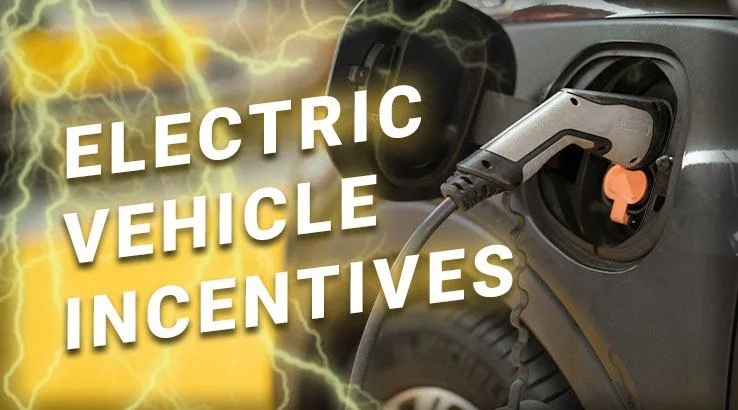Listed: Electric vehicle subsidies for each Australian state

Here are the available electric vehicle incentives, broken down by state and territory.
 Sponsored by People's Choice, flexible personal loans and car loans. Whether you want to buy a new car, renovate your home, refinance an existing loan or go on a dream holiday, we can help you get a fair personal loan that's right for you.
Sponsored by People's Choice, flexible personal loans and car loans. Whether you want to buy a new car, renovate your home, refinance an existing loan or go on a dream holiday, we can help you get a fair personal loan that's right for you.
45% of Australian drivers are open to the idea of buying an electric car. Now, doing so could save you thousands of dollars thanks to state subsidies and registration exemptions (depending on where you live):
South Australia
South Australians can access 2 electric vehicle incentives:
- $3,000 subsidy for 7,000 new electric vehicles. The first 7,000 electric vehicles (bought from 28 October 2021) qualify for a $3,000 subsidy. There's a catch though, as the models have to be worth less than $68,750 (inclusive of GST).
- 3-year rego fee exemption. New electric vehicles, bought between 28 October 2021 and 30 June 2025, receive a 3-year rego fee exemption. That's providing they are valued below the $68,750 (including GST) price threshold.
Victoria
Victorians can apply for the following:
- $3,000 rebate for 20,000 zero emission vehicles. Solar Victoria is releasing Zero Emission Vehicle subsides in incremental batches. Up to 20,000 will be made available (2,461 remain in the current release, as of 16 November 2021). However, the electric car needs to have a dutiable value below $68,740, which rules out many of the luxury electric vehicles.
- $100 registration concession. Electric vehicles fall into the ZLEV band and qualify for a $100 rego discount which is automatically deducted from the fee.
On the flip side of the Zero Emission Vehicle subsidies, since 1 July 2021, Victoria has levied electric vehicles with a road-user charge. The charge is 2.5 cents per kilometre. VicRoads estimates the average driver would pay $337.50 in Zero and Low Emission Vehicles (ZLEV) road-user charges, annually.
Australian Capital Territory
The Australian Capital Territory claims to have the most considerable electric vehicle subsidies in the country.
This is thanks to the territory's Zero Emission Vehicle incentives.
ACT electric vehicle buyers benefit from:
- Brand new electric vehicles stamp duty exemption. Zero emission vehicles are placed in the 0-130g/km performance band, meaning you pay no duty. If you were going to buy a performance vehicle, for example, the Mercedes-Benz E-Class E53 4MATIC+ (a sedan, roughly comparable to the Tesla Model S), you'd pay around $7,805 stamp duty.
- Free rego for new and used Zero Emission Vehicles. Electric vehicles bought between 24 May 2021 and 30 June 2024 benefit from 2 years of free registration. Using the Mercedes from above as a comparison, this measure would save electric vehicle buyers as much as $1,019.90. However, you still have to pay other costs like Motor Accident Injuries Insurance (MAI) and the vehicle must be garaged within the ACT to qualify. If you bought the car before the qualifying date of 24 May 2021, you will instead benefit from a 20% discount on registration costs.
New South Wales
New South Wales electric vehicle motorists can avail themselves of the following EV rebates:
- Stamp duty refunds for electric vehicles valued under $78,000. New and used EVs, with a dutiable value below $78,000, qualify for a stamp duty exemption. The vehicle needs to be purchased after 1 September 2021 to qualify. Revenue NSW aims to get the refund approved and processed within 20 days of submitting your application. Cars like the Tesla Model 3 (RWD model), MG ZS EV Essence and Hyundai Kona Electric Highlander would likely meet the requirements thanks to their lower list prices.
- $3,000 cash rebates for the first 25,000 new EVs sold after 1 September 2021. Vehicles have to have a dutiable value under $68,750 and cannot be acquired through a novated leasing deal. One rebate is available per person.
Be aware that by 2027 (or when electric vehicles account for 30% of all new vehicle sales), you'll have to pay a distanced-based road user charge of 2.5 cents per kilometre for an electric car. The NSW Government estimates this will amount to an average $315 yearly cost.
Northern Territory
Northern Territory electric vehicle buyers get the most stingy incentives.
- Reduced rate electric vehicle registration. Electric vehicle buyers pay less rego. You'll pay the same as vehicles with a 501-1,000cc capacity engine, like the Kia Picanto GT – $677.75 for 12 months. However, that's less than the typical performance vehicle, where you'd expect to pay between $833.75 and $1,272.75.
If you're thinking of buying an EV in the Northern Territory, you might be best waiting until July 2022, when the government plans to introduce registration exemptions and stamp duty reductions of $1,500 for 5 years.
Queensland
Eligible Queenslanders can save money thanks to the following incentive:
- Plug-in and battery-electric vehicles have a reduced registration duty rate. For vehicles with up to $100,000 of dutiable value, you pay at a rate of $2 per $100. For those over $100,000, it's $4. Duty can reach as high as $6 per $100 on V8-engined vehicles. Using Queensland Government's vehicle registration duty calculator, the duty payable on a Tesla Model S ($170 including GST and LCT) would be $6,820, where the Mercedes-Benz would be $9,383, a difference of $2,563.
- A $3,000 rebate applies to affordable EVs. From 1 July 2022, a rebate of $3,000 will be offered to those purchasing a battery-electric vehicle priced under $58,000, a low threshold given the price of many EVs, but it does include the Hyundai Kona Electric Short Range, Hyundai Ioniq, Nissan Leaf, MG ZS EV and Mini Cooper SE. Given the timing of the subsidy's launch, it might pay to hold off on making the switch until the new financial year to take advantage of it if you're considering any of these applicable vehicles.
Tasmania
Tasmanian electric car buyers receive the following exemption:
- New and used electric vehicles have a stamp duty exemption. Electric vehicles are exempt from stamp duty (from 10 July 2021, though exemption can be backdated to 1 July 2021), which ordinarily could cost as much as $4 for every $100 of the vehicle value. For the Mercedes-Benz E-Class E 53 4MATIC+ sedan, stamp duty in Tasmania works out to $6,964, whereas a Tesla Model S buyer wouldn't pay any!
Western Australia
Western Australia was the last state to offer rebates or subsidies for EVs. However, in May 2022, the state announced it would make $36.5 million available to fund 10,000 electric vehicle subsidies.
If your EV is worth under $70,000, then you may qualify for a $3,500 rebate.
Electric vehicle federal incentives
Currently, the only federal-level electric vehicle incentive available is a higher Luxury Car Tax (LCT) threshold, specifically for "fuel-efficient cars".
LCT is applied to vehicles with a GST-inclusive value over a set cost. A 33% taxation is levied on the value above the GST-inclusive price. For standard, non-green vehicles, the LCT limit is $69,152. For "fuel-efficient" models though, the LCT threshold is a significantly higher $79,659.
Tesla Australia states this could save buyers up to $3,152.
Future government plans for electric vehicles
In the future, the Australian Government predicts there will be more electric vehicles on public roads. In fact, it is projecting electric vehicle sales to reach 30% of overall new light vehicle orders by 2030 and account for 90% by 2050. As a result, it is investing predominantly in charging infrastructure. States and territories have followed suit and published their own transport electrification strategies.
One response to electric vehicles, which don't need to pay the flat sales tax applied to fuels, is to introduce road user fees, which are charged per kilometre.
Electric vehicle buying tips
- To qualify for the maximum amount of subsidies and rego discounts, you'll need to buy a car below the threshold set out by your state. That's because most of the states and territories have set limits on their exemptions and rebates below the government's $79,659 Luxury Car Tax threshold.
- To lower your monthly loan repayments, you could opt for a cheaper electric car trim grade. The difference between 2 trims can be thousands of dollars. However, that can typically mean you get a shorter range or fewer passenger comforts, so you need to consider whether it's worth the savings.
- If you're thinking about buying an electric car, but aren't sure which one to go for, we've put together detailed comparison reviews of the most popular electric cars.
- Before you switch to an electric car, keep a log of how far you typically travel per day. You might be surprised to learn that even the shortest ranged electric vehicle can cover that distance.
- Make sure to read our electric car ownership guide for more pointers on making the transition to electric power.
The People's Choice Discounted Personal Loan (Car Loan) offers a low rate of 4.65% p.a. (4.99% p.a. comparison) with fast pre-approval, flexible loan terms and is available when loans are secured against a new or used car or caravan up to 5 years of age with a loan value greater than $20,000. T&Cs apply.
